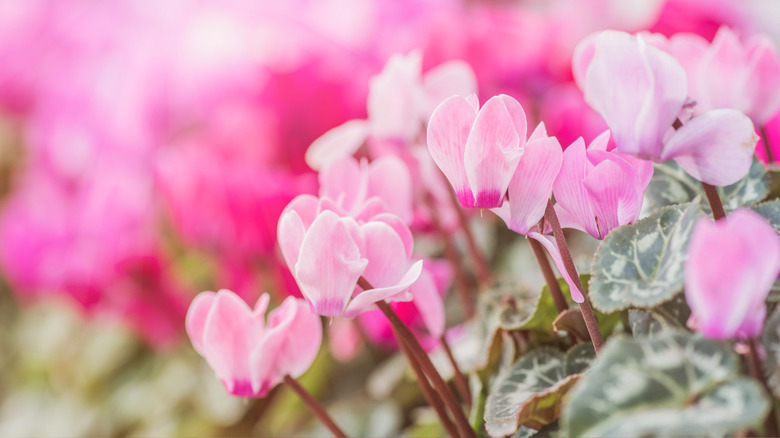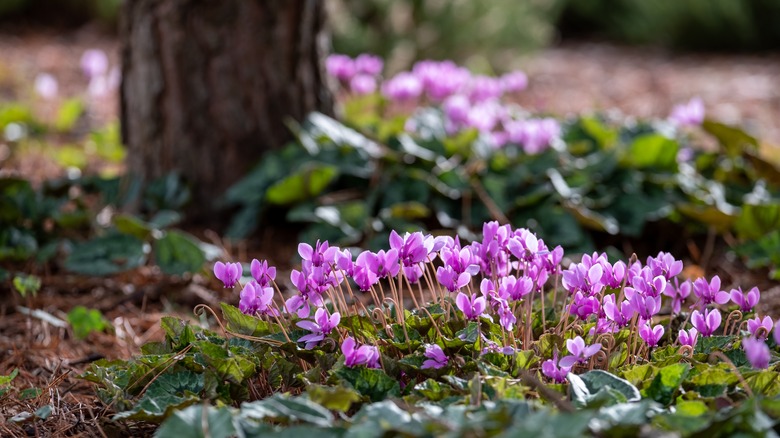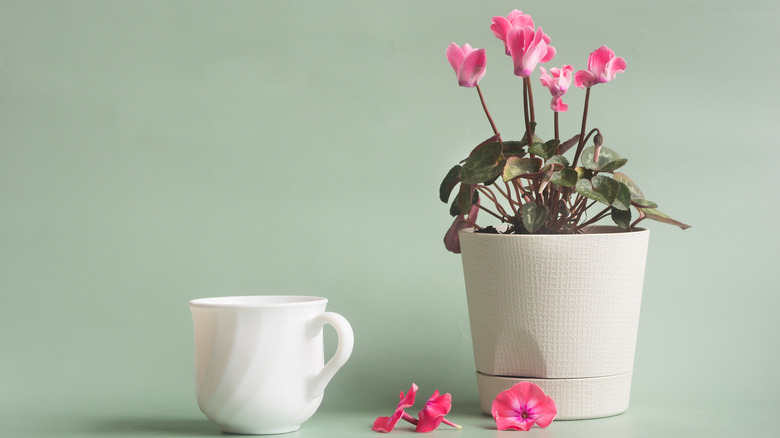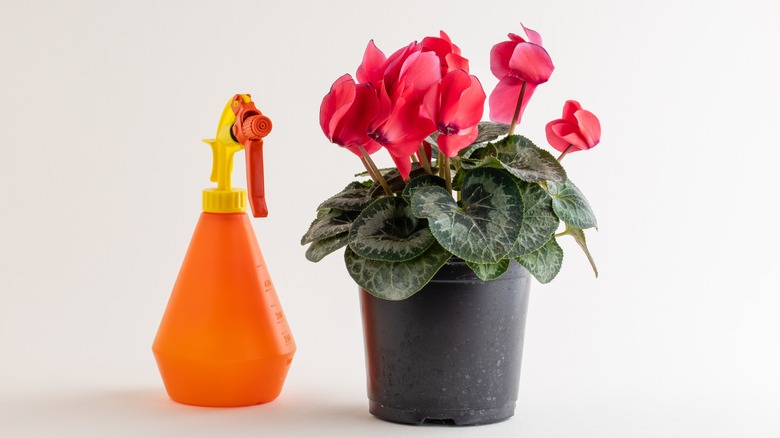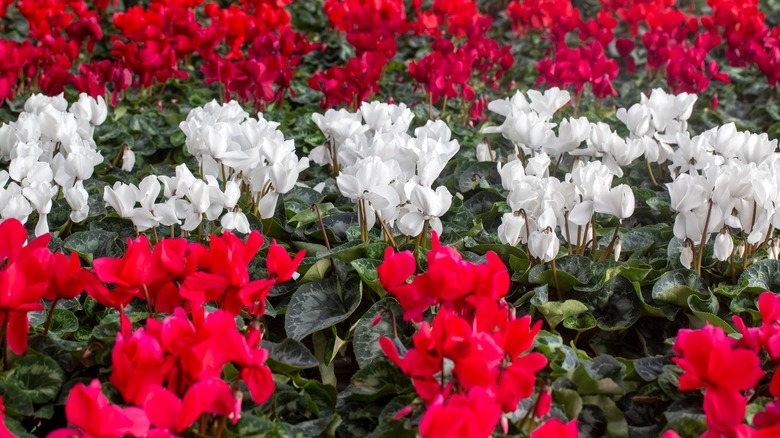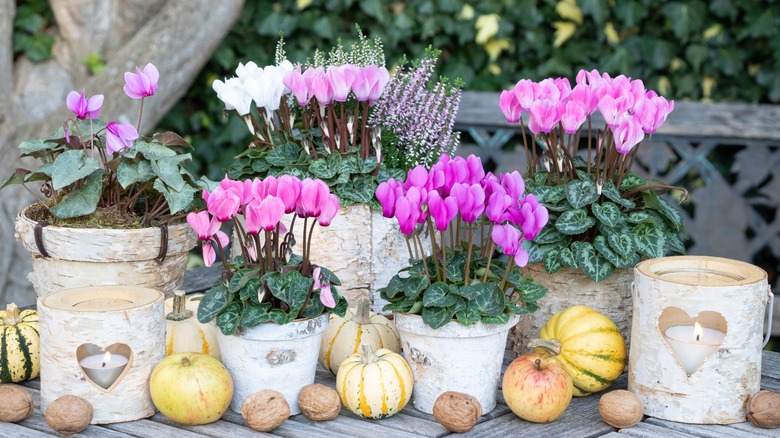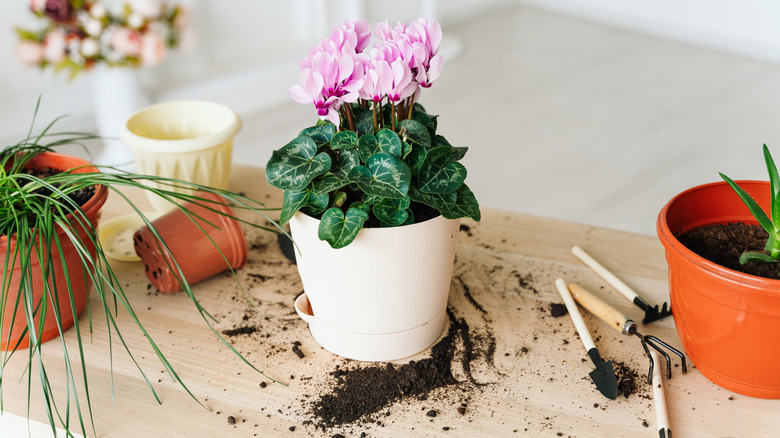How To Take Care Of Your Cyclamen Plant
Native to the Mediterranean region, cyclamen (cyclamen persicum) is a perennial flowering plant with small, straight blooms, and can be found in a variety of colors, namely pink, white, and red (via The Spruce). Cyclamen have a long history of uses and symbolism. According to Pansy Maiden, the flowering plant was used medicinally in antiquity as an aphrodisiacal aid, administered in cakes and oils. It also has various symbolic meanings in Christianity. The flowers have been nicknamed "bleeding nun" and "Incense of the Virgin Mary," due to their representation of immaculate conception, grief, and purity. Many churches and shrines dedicated to Mary decorate with cyclamens.
A Chinese fairytale says the plant's seeds came from a rabbit that lived on the moon with the moon goddess Chang'e, who gifted it to a gardener. When it grew, the cyclamen sprouted, which resembled the ears of a bunny. The plant gets its current name from the Greek word kyklos, meaning ring or circle. It has also been referred to as sowbread, swinebread, pig turnip, and stag truffle (due to pig's tendency to dig up and eat the roots) and soap of the shepherds (due to its natural detergent properties).
This perennial plant is often grown indoors as a houseplant, but can also be grown outdoors in appropriate climates. These small flowering plants are a great addition to your indoor or outdoor garden, offering a pleasant sweet scent and beautiful flowers.
How to use cyclamen in garden
Cyclamen are native to the Mediterranean, and those needs should be met when grown outdoors. Hardy cyclamen, the variety most commonly grown outside, grow best in USDA hardiness zones 5 through 8, according to the Evening Sun. The green leaves offer a glint of silver variegation, and the bright flowers will grow anywhere from 3 to 5 inches tall, offering dots of color. Keep in mind that florist's cyclamen requires much warmer weather to be grown outdoors.
According to Plant Delights, cyclamen are best grown under trees and shrubs as ground cover. Some companion plants they recommend are clumping plants like buttercups, crocus, galanthus, and hostas. Gardening Know How also says they plant well with hellebores, ajuga, and trillium. When all these flowers are planted together under majestic tall trees, your backyard will transform into a magical fairytale cottage. Cyclamen are easiest to plant outdoors from bulbs in the late summer or early fall.
How to grow cyclamen
Cyclamen can be propagated and grown a couple different ways — namely, growing by seed or propagating by plant division, according to Gardening Know How. Florist's cyclamen and hardy cyclamen benefit from different propagation methods. Within those species, different varieties require different approaches. Check with your species and variety before going full force into one method.
Hardy cyclamen do best with plant division, done by dividing and replanting the tubular roots. In the early fall, dig up or unpot the plant and examine the tuber roots. Gently divide and separate them, then replant them under a couple inches of soil. If you do this early enough, they should begin to root by winter.
Seed propagation is a successful method for both hardy and florist's cyclamen, but requires some patience. If you want to grow the plant outdoors, start this method in the spring, once it's at least 45 degrees outside consistently. Indoors, do this in the winter. 24 hours before you want to start planting, soak your seeds in room temperature water. Pot in their appropriate conditions, depending on the species and variety. Outdoors, expect blooms the next year. Indoors, the plant may bloom by that spring.
How to care for cyclamen
Cyclamen are commonly grown indoors as a houseplant which goes dormant and stops blossoming, but it still provides gorgeous green foliage. According to The Spruce, cyclamen prefer being exposed to bright, indirect light in the winter during their growing season. However, they should be moved to a darker spot in the summer when they go dormant. As for water, the plant should be watered when the top inch of soil is dry during growing seasons. When dormant, only water when it's mostly dried out. Alternatively, consider bottom watering so it only takes what it needs.
Cyclamen prefer to be kept humid, especially during the winter. Utilize a pebble tray, mist frequently, or place it next to a humidifier. As for fertilizer, feed the plant when it's in its growing season every two weeks or so with a liquid-based low nitrogen fertilizer, diluted down a bit with water. Prune and remove dead leaves during the growing season and when it's going dormant to prevent rot.
Varieties of cyclamen
Cyclamen grow in a multitude of varieties, offering different colors, heights, foliage, etc. There are multiple varieties within both hardy and florist's cyclamen, though this list will focus specifically on florist's cyclamen varieties. Per Home Stratosphere, here are just a few varieties of cyclamen persicum.
-
Cyclamen Creticum — Native to Crete and Karpathos, this variety bears white, sometimes pink, lily-scented flowers that grow anywhere from 4 to 12 centimeters long, blooming from February to May.
-
Cyclamen Pseudibericum — This purple-pink variety grows in February and March, and grows 5 to 10 centimeters tall.
-
Cyclamen Alpinum — This variety can bloom pink or purple flowers that produce a lovely, primrose scent, and can grow up to 8 centimeters tall.
-
Cyclamen Libanoticum — A rare variety sporting soft pink flowers, this variety is native to Lebanon, and grows 5 to 10 centimeters tall. It blooms in March.
-
Cyclamen Hederifolium — Also known as ivy-leaved cyclamen and Neapolitan cyclamen, this variety grows up to 12 centimeters tall and blooms in shades of white and pink.
Is cyclamen toxic?
Cyclamen, though they used to be baked into cakes for their aphrodisiac qualities, are actually toxic to humans and animals. The ASPCA lists cyclamen as toxic to both cats and dogs, too. This is due to terpenoid saponins. Poisoning symptoms to look for in your pets include drooling and increased salivation, as well as gastrointestinal irritation such as vomiting and diarrhea. If they ingest the tuber roots, it can result in abnormal heart beats, seizures, and even death. If you suspect your pet has eaten the plant, contact your vet immediately. Bring the part of the plant they ingested to your vet so they can determine how to care for your furry friend.
The tubers are also poisonous to humans, according to Cornwall Manor. Consumption of the tubers can lead to severe vomiting and diarrhea, irregular heartbeat, seizures, and death. This will only happen when consumed in large quantities, but consumption of any part of the plant should be avoided.
How to repot cyclamen
According to Gardening Know How, cyclamen should generally be repotted every two years. Young plants will likely have to be repotted a pot size up, but older plants should still be repotted to have their dirt refreshed, even if in the same pot. Do so in the plant's dormant period, which is usually in the summer.
Remove the cyclamen from its current pot and assess the tuber and root system. Remove any old, mushy, or rotten bits. Separate the tuber if you want to propagate more. Brush off as much old soil as possible. Cyclamen prefer a more acidic soil, according to The Spruce. Alternatively, use a regular, well draining potting soil and mix in sphagnum peat.
Place the tuber in the new pot, and cover with soil. Water to expose air pockets, fill, and repeat until filled. Keep the plant shaded somewhere dry until its growing season begins, at which point you can start watering again.
